Corrigendum to “Clusters of Galaxies in a Weyl Geometric Approach to Gravity”
In the article titled “Clusters of Galaxies in a Weyl Geometric Approach to Gravity” [1], there was an error in equation (47) that led to a wrong relation between the acceleration due to the scale connection (aφ) and the acceleration arising from the scalar field energy density (asf). The correction of (47) has consequences for the model. It makes a new run of the data evaluation based on the corrected dynamical equations necessary. The new results are given in updated Tables 3 and 4 and Figures 1–6. The overall picture of the empirical test does not change, although now three rather than two galaxy clusters agree with the model only in the 2σ range. To facilitate controlling the correction, a detailed derivation of the corrected equation (47) is given in Appendix.
| Cluster | r500 | Mtot(r500) | M500 | r200 | Mtot(r200) | M200 |
|---|---|---|---|---|---|---|
| Coma | 1278 |
|
|
2300 |
|
|
| A85 | 1216 |
|
|
1900 |
|
|
| A400 | 712 |
|
|
1093 |
|
|
| IIIZw54 | 731 |
|
|
1350 |
|
|
| A1367 | 893 |
|
|
1529 |
|
|
| MKW4 | 580 |
|
|
857 |
|
|
| ZwCl215 | 1098 |
|
|
2093 |
|
|
| A1650 | 1087 |
|
|
2150 |
|
|
| A1795 | 1118 |
|
|
2136 |
|
|
| MKW8 | 715 |
|
|
1279 |
|
|
| A2029 | 1275 |
|
|
2286 |
|
|
| A2052 | 875 |
|
|
1250 |
|
|
| MKW3S | 905 |
|
|
1450 |
|
|
| A2065 | 1008 |
|
|
2450 |
|
|
| A2142 | 1449 |
|
|
2364 |
|
|
| A2147 | 1064 |
|
|
1450 |
|
|
| A2199 | 957 |
|
|
1621 |
|
|
| A2255 | 1072 |
|
|
2271 |
|
|
| A2589 | 848 |
|
|
1471 |
|
|
- Model values Mtot(rN00) and empirical values MN00 in 1014 M⊙, rN00 (empirical) in kpc (N = 1,2).
| Cluster | Mt | Msf | Msf2 | Mph1 | Mgas | M∗ | f∗ | ft |
|---|---|---|---|---|---|---|---|---|
| Coma | 11.15 | 6.44 | 1.73 | 4.71 | 1.77 | 0.276 | 0.16 | 6.3 |
| A85 | 8.03 | 4.52 | 1.01 | 3.51 | 1.54 | 0.140 | 0.09 | 5.2 |
| A400 | 2.27 | 1.36 | 0.45 | 0.91 | 0.26 | 0.084 | 0.32 | 8.7 |
| IIIZw54 | 2.77 | 1.65 | 0.54 | 1.11 | 0.25 | 0.080 | 0.32 | 10.9 |
| A1367 | 3.77 | 2.21 | 0.65 | 1.56 | 0.42 | 0.089 | 0.21 | 8.9 |
| MKW4 | 0.99 | 0.58 | 0.18 | 0.40 | 0.09 | 0.022 | 0.25 | 10.9 |
| ZwCl215 | 8.00 | 4.55 | 1.11 | 3.45 | 1.19 | 0.137 | 0.12 | 6.7 |
| A1650 | 8.15 | 4.69 | 1.24 | 3.45 | 1.10 | 0.162 | 0.15 | 7.4 |
| A1795 | 8.04 | 4.59 | 1.14 | 3.45 | 1.15 | 0.14 | 0.12 | 7.0 |
| MKW8 | 2.12 | 1.24 | 0.36 | 0.88 | 0.20 | 0.039 | 0.20 | 10.8 |
| A2029 | 12.83 | 7.15 | 1.47 | 5.68 | 2.83 | 0.203 | 0.07 | 4.5 |
| A2052 | 2.58 | 1.50 | 0.43 | 1.07 | 0.31 | 0.059 | 0.19 | 8.3 |
| MKW3S | 3.35 | 1.95 | 0.55 | 1.40 | 0.39 | 0.072 | 0.18 | 8.5 |
| A2065 | 10.28 | 5.80 | 1.32 | 4.48 | 1.48 | 0.142 | 0.10 | 6.9 |
| A2142 | 12.55 | 6.95 | 1.35 | 5.60 | 2.59 | 0.159 | 0.06 | 4.8 |
| A2147 | 4.83 | 2.77 | 0.71 | 2.06 | 0.87 | 0.118 | 0.14 | 5.5 |
| A2199 | 4.36 | 2.52 | 0.68 | 1.84 | 0.55 | 0.088 | 0.16 | 8.0 |
| A2255 | 10.35 | 5.84 | 1.33 | 4.51 | 1.76 | 0.166 | 0.09 | 5.9 |
| A2589 | 3.99 | 2.33 | 0.68 | 1.65 | 0.52 | 0.105 | 0.20 | 7.7 |
- Mass values in 1014 M⊙, f∗ = M∗/Mgas, ft = (Mt/Mgas)(r200); for r200 see Table 2.
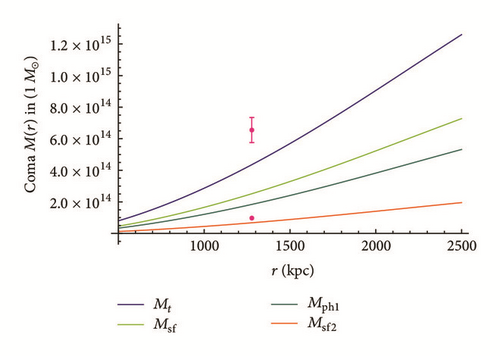
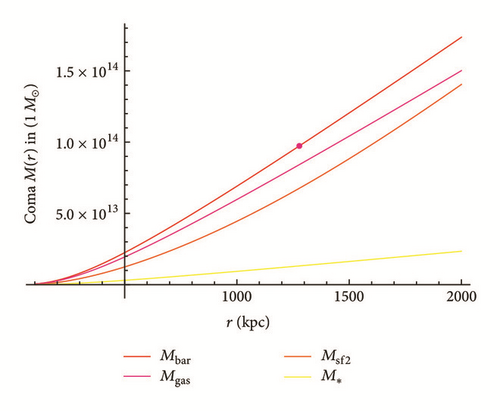
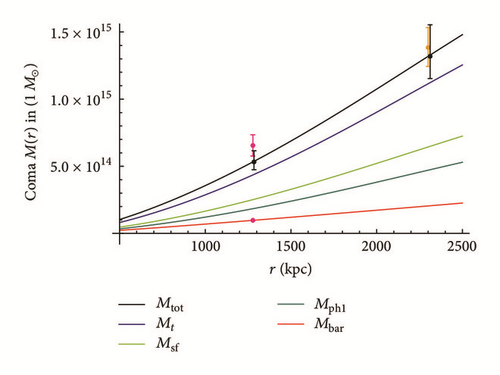
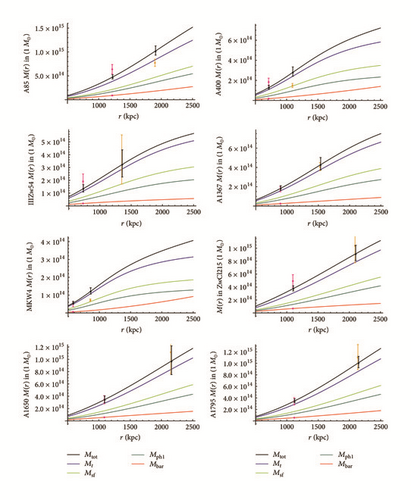
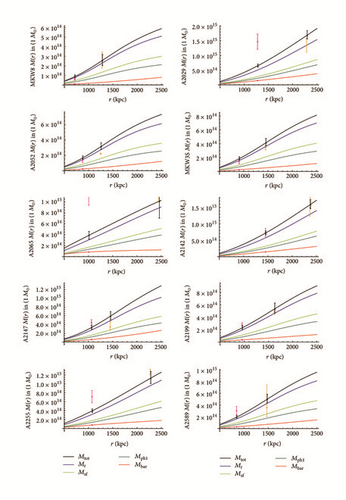

Minor Corrections. “15” should be changed to “14” in the following two sections. In the abstract, the number should be corrected in the phrase “the total mass for 15 of the outlier reduced ensemble of 17 clusters seems to be predicted correctly (in the sense of overlapping 1σ error intervals).” In paragraph 6 of Introduction, it should be corrected in the sentence “For 15 of the 17 main reference clusters the empirical and the theoretical values for the total mass agree in the sense of overlapping 1σ error intervals.” Equations (28), (57), and (58) should read as follows.
-
For 5 clusters A85, A2255, and A2589 and the outliers A2029 and A2065, the error intervals of empirical data and model data do not overlap. For the first three of them (A85, A2255, and A2589) the model predictions are consistent with the empirical data within doubled error intervals (2σ range).
In page 20, right column (Section 5), 20, at the middle of the second paragraph “15 clusters” should be replaced with “14 clusters,” and “Two clusters …” should be substituted by “Three clusters …” at the beginning of the last phrase.




